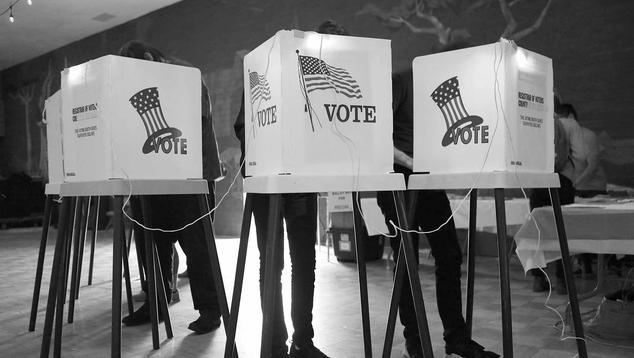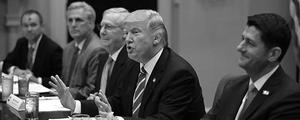Story Highlights
- Republicans and Democrats equally likely to be certain they'll vote
- Enthusiasm for voting running at record high among all party groups
- Democrats have rare advantage on thought given to election
WASHINGTON, D.C. -- In a departure from Republicans' usual lead on midterm turnout indicators, Democrats appear to be on par with or possibly ahead of Republicans in eagerness and intent to vote this year. Three-quarters of both party groups, 74%, say they are "absolutely certain" they will vote on or before Election Day. Republicans and Democrats are also about equally likely to report feeling "more enthusiastic than usual" about voting. At the same time, Democrats are more likely than Republicans to say they have given "quite a lot of thought" to the election.
| U.S. adults | Republicans | Independents | Democrats | ||||||||||||||||||||||||||||||||||||||||||||||||||||||||||||||||||||||||||||||||||||||||||||||||
|---|---|---|---|---|---|---|---|---|---|---|---|---|---|---|---|---|---|---|---|---|---|---|---|---|---|---|---|---|---|---|---|---|---|---|---|---|---|---|---|---|---|---|---|---|---|---|---|---|---|---|---|---|---|---|---|---|---|---|---|---|---|---|---|---|---|---|---|---|---|---|---|---|---|---|---|---|---|---|---|---|---|---|---|---|---|---|---|---|---|---|---|---|---|---|---|---|---|---|---|
| % | % | % | % | ||||||||||||||||||||||||||||||||||||||||||||||||||||||||||||||||||||||||||||||||||||||||||||||||
| Absolutely certain will vote | 67 | 74 | 52 | 74 | |||||||||||||||||||||||||||||||||||||||||||||||||||||||||||||||||||||||||||||||||||||||||||||||
| More enthusiastic than usual about voting | 64 | 72 | 51 | 69 | |||||||||||||||||||||||||||||||||||||||||||||||||||||||||||||||||||||||||||||||||||||||||||||||
| Given quite a lot of thought to the election | 54 | 55 | 46 | 62 | |||||||||||||||||||||||||||||||||||||||||||||||||||||||||||||||||||||||||||||||||||||||||||||||
| GALLUP, Oct. 15-28, 2018 | |||||||||||||||||||||||||||||||||||||||||||||||||||||||||||||||||||||||||||||||||||||||||||||||||||
These findings are based on an Oct. 15-28 Gallup poll, which also shows that the political environment heading into the 2018 midterms is a challenging one for the party in control of the U.S. House -- that is, Republicans -- given low presidential approval, low Congress approval and subdued satisfaction with the way things are going in the country.
Democrats Leading on Key "Thought" Indicator
Republicans typically enjoy a comfortable lead over Democrats in giving "quite a lot of thought" to midterm elections -- a key historical Gallup indicator of turnout propensity. But that GOP advantage is not evident this year, as 55% of Republicans vs. 62% of Democrats say they have given the election quite a lot of thought.
In fact, Republicans' seven-percentage-point deficit in thought represents the only time they have trailed Democrats on Gallup's final pre-election reading of this measure in midterm years dating back to 1994.
Before now, in all but one year, Republicans have led by six to 12 percentage points. The only exception was 2006 -- a strong Democratic year -- when the Republicans had a mere two-point edge.
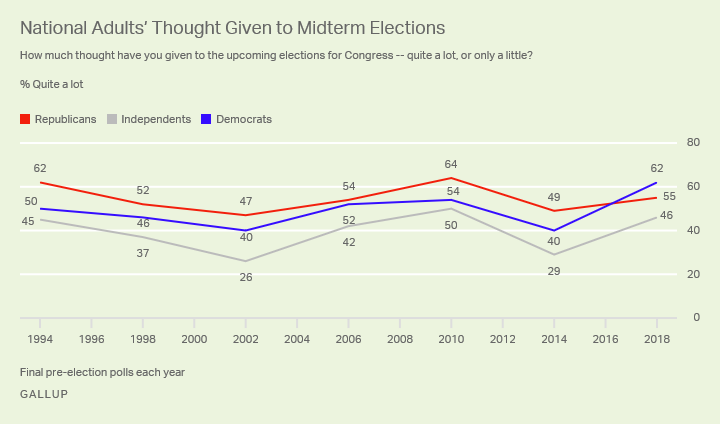
Parties Tie on Certainty of Voting
The partisan gap in U.S. adults' self-reported intention to vote has typically been smaller than that seen for thought given to the election, but normally Republicans have a slight edge in saying they are "absolutely certain to vote." This year, however, the two parties are equally likely to say this.
Republican leads on certainty to vote in 1994, 2010 and 2014 all coincided with strong gains for the GOP in U.S. House seats. However, the implication of the parties being tied, as they are this year, is less clear. When they were roughly tied in 2002, the Republicans gained a modest number of seats, while in 2006 they suffered significant losses. Although Democrats picked up a few seats in 1998 when the Republicans led slightly on this measure, 72% to 69%, that represented a minimal seat loss for the GOP majority in a midterm year.
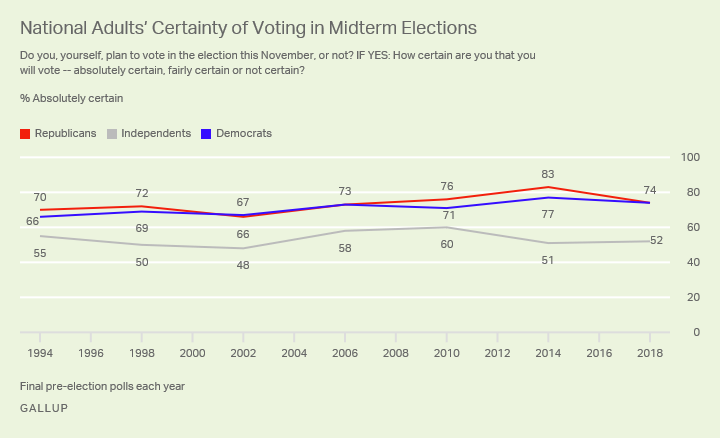
Party Groups Feeling More Enthusiastic About Voting Than Usual
All three party groups -- Republicans, independents and Democrats -- are showing record enthusiasm for voting this year compared with the 1994-2014 trend, potentially reflecting a more highly charged political atmosphere than in the past.
Enthusiasm about voting is not so much an indicator of what the turnout rate will be as it is a potential clue to which party is likely to fare better in the election. Gallup analysis has found that the more enthusiastic party is not necessarily the one with higher turnout but does tend to correspond with the party that ultimately wins the most seats -- indicating that partisans have an advance sense of the direction in which a given election is headed. This was borne out in 1994, 2010 and 2014, when Republicans led Democrats in enthusiasm by eight or more points and enjoyed double-digit seat gains in the House, winning or maintaining party control of that body.
By contrast, in the one year Republicans trailed Democrats on this enthusiasm measure -- 2006 -- Republicans lost a large number of seats and, consequently, majority control of Congress. Their current three-point edge over Democrats on this is statistically similar to 1998 and 2002, both years when the president's party picked up a handful of seats but the balance of power in Congress didn't change.
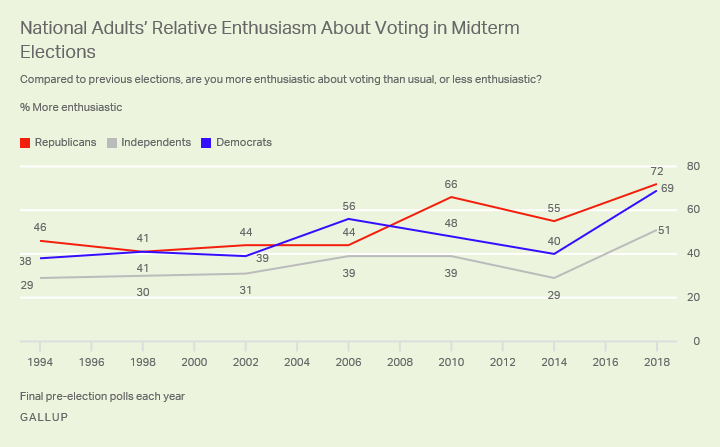
Turnout Likely to Be Robust
In the past six midterm elections, from 1994 through 2014, voter turnout has spanned a fairly narrow range from 37% (in 2014) to 41% (in 1994 and 2010).
Turnout in 2018 appears headed toward the upper end of that range, based on the overall percentages of Americans who say they are certain to vote and have given quite a lot of thought to the election. The two questions have historically been closely related to turnout.
More specifically, the 67% of Americans this year saying they are absolutely certain to vote and the 54% who have given quite a lot of thought to the election are significantly higher than the final pre-election figures for each measure in 2014 (the low-turnout year). Yet they are similar to 2010 figures (a high-turnout year). The current figures are also slightly higher than or on par with those recorded in 2006 and 1994 -- years when turnout was in the 40% to 41% range.
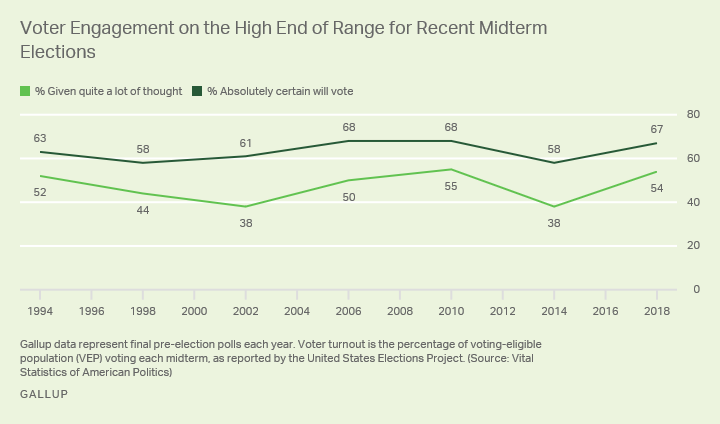
Meanwhile, as noted above in reference to party differences in enthusiasm, and continuing the pattern Gallup saw in September, voter enthusiasm among all Americans continues to run significantly higher than usual.
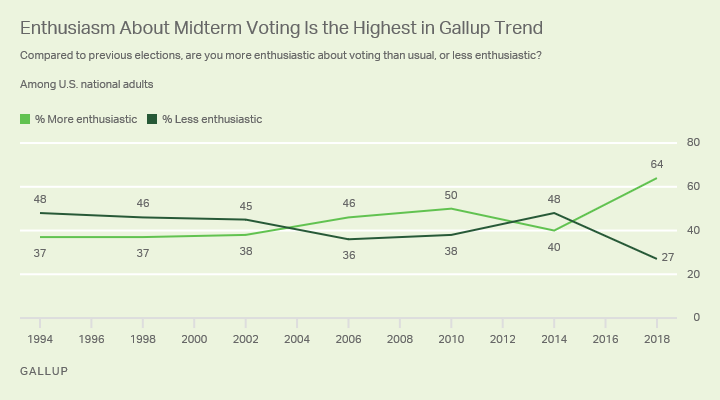
Bottom Line
While the proportion of Americans who vote in midterm elections is important for civic reasons, the difference in turnout between Republicans and Democrats holds potentially greater significance, as this can affect the outcome. On the eve of the 2018 midterms, all signs point to Democrats holding their own with Republicans on turnout.
This is notable because typical Republican advantages on voter turnout help the party overcome Democrats' usual advantage in party identification among the adult population, and therefore in voter support for Democratic candidates. Without that advantage, Republicans are far less likely to retain their majority in the U.S. House in this election.
View complete question responses and trends.
Learn more about how the Gallup U.S. Poll works.
